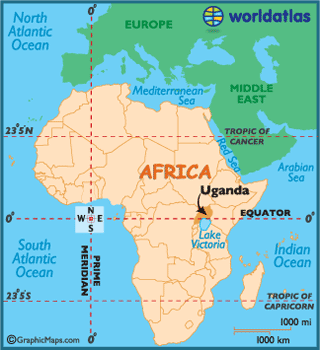Australian Plants on Uganda Stamps
These stamps were issued in Uganda in 1991, in consultation with the Royal Botanic Gardens, Melbourne.
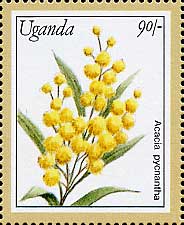 |
Plant: Acacia pycnanthaFamily: Fabaceae (Mimosaceae) Golden Wattle
Medium shrub or small tree to 10m. |
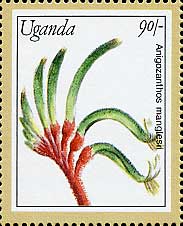 |
Plant: Anigozanthos manglesiiFamily: Haemodoraceae Red and Green Kangaroo Paw The grey-green leaves are strap-like and up to 40 cm long. |
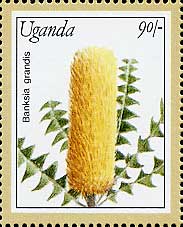 |
Plant: Banksia grandisFamily: Proteaceae Bull Banksia Variable plant from spreading shrub 1.5 m high and 3 m across, to a tree 10 m high. |
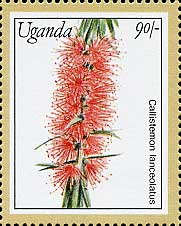 |
Plant: Callistemon citrinus(Once known as Callistemon lanceolatus) Family: Myrtaceae Crimson Bottlebrush Stiff shrub or small tree to 6 m high with lanceolate leaves to 8 cm. |
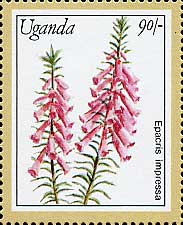 |
Plant: Epacris impressaFamily: Ericaceae Pink Heath
Straggly shrub to 1m high. |
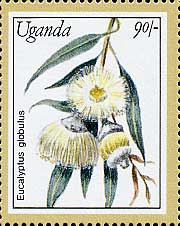 |
Plant: Eucalyptus globulusFamily: Myrtaceae Tasmanian Blue Gum
Medium to large tree to 45m high. |
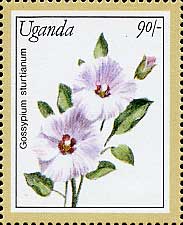 |
Plant: Gossypium sturtianumFamily: Malvaceae Sturt’s Desert Rose Erect or rounded shrub to 2 m, often less. Rounded, glaucous leaves to 6 cm diameter. Hibiscus-like flowers, pale bluish-purple with red centre, to 12 cm diameter, occur in winter and spring. |
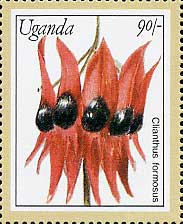 |
Plant: Swainsona formosa(Once known as Clianthus formosus) Family: Fabaceae Sturt's Desert Pea Trailing plant with grey, pinnate leaves to 15 cm long, on stems spreading to 2 m. It may be an annual or short-lived perennial. Bears pea-flowers, 5–6 cm long, of brilliant red with black boss on erect peduncles. Other colour variants are known. Flowers appear in spring. Floral emblem of South Australia. |
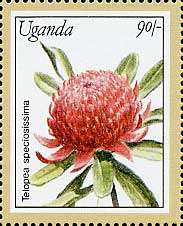 |
Plant: Telopea speciosissimaFamily: Proteaceae New South Wales Waratah Erect shrub to 3 m high by 1.5 m across. Leaves are obovate, to 15 cm, often toothed or lobed. Bears red flowers in spring in large terminal inflorescences to 15 cm diameter and surrounded by large red bracts. |
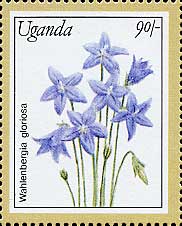 |
Plant: Wahlenbergia gloriosaFamily: Campanulaceae Royal Bluebell
Herbaceous suckering plant. |
Sources:
Chinese language website 2013: http://www.plantstamps.net/stamps/uganda.htm
Uganda Map: http://www.worldatlas.com/webimage/countrys/africa/ug.htm
Plant information: Wrigley and Fagg, Australian Native Plants, 2003
![An Australian Government Initiative [logo]](/images/austgovt_brown_90px.gif)


